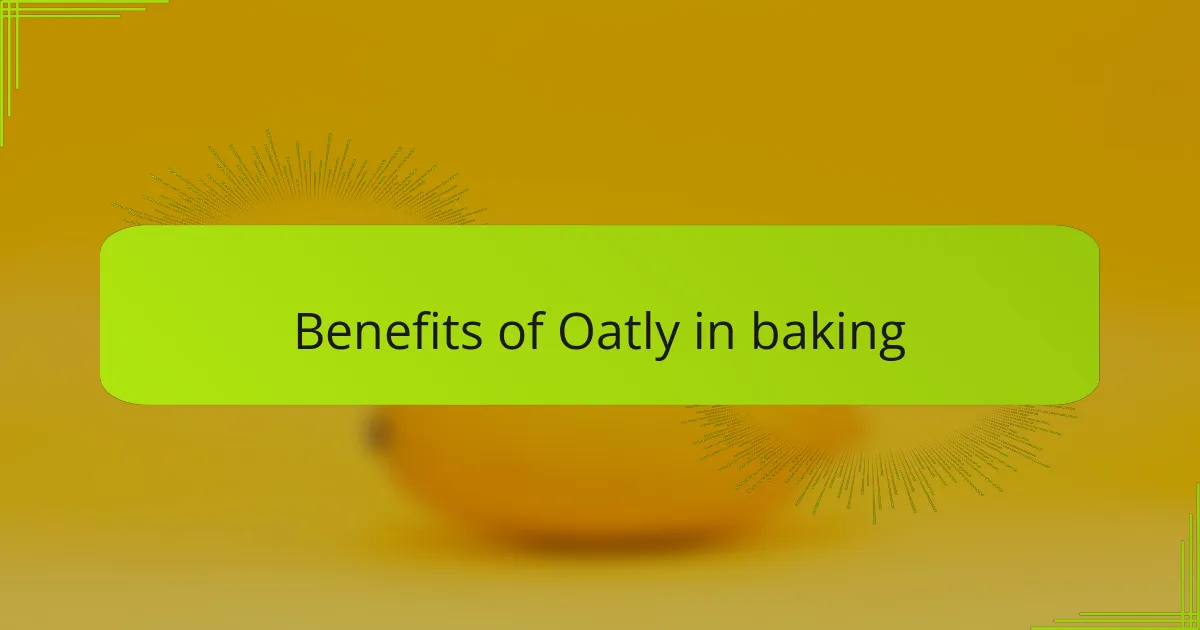Key takeaways
- Oatly is a versatile oat-based milk alternative that enhances texture and flavor in baking, especially in pie crusts.
- Using Oatly adds moisture and tenderness without making crusts soggy, creating a reliable and consistent baking experience.
- Key techniques for successful Oatly pie crusts include using chilled Oatly, adding liquid gradually, and allowing the dough to rest in the fridge.
- Switching to Oatly can boost confidence in baking, leading to beautifully tender, flaky crusts and an enjoyable kitchen experience.

What is Oatly and its uses
Oatly is a popular oat-based milk alternative that has gained a strong following for its creamy texture and mild, slightly sweet flavor. I remember the first time I tried it—it felt like discovering a whole new world of possibilities outside of traditional dairy.
Beyond just drinking it, Oatly’s versatility surprises many. Have you ever thought about using a dairy substitute in baking? From my experience, it works wonderfully in recipes that need moisture, like pie crusts, without overpowering other flavors.
What makes Oatly stand out for me is how it balances practicality and taste. Unlike some plant-based milks that can be watery or thin, Oatly adds body and richness, which is key when you want that perfect flaky crust. Have you ever had a crust that just falls flat? Oatly can be a game-changer there.

Benefits of Oatly in baking
One of the main benefits I’ve noticed when using Oatly in baking is how it enhances the texture. It gives pie crusts a lovely tenderness without making them soggy, which is something I struggled with when using other milk alternatives. Have you ever had a crust that ends up dry or crumbly? Oatly really helps keep it tender and flaky at the same time.
Another plus is the subtle sweetness Oatly brings to the table. It’s gentle and natural, so it doesn’t compete with the other flavors in your dessert. I found this especially true when baking fruit pies—Oatly complements the filling instead of overshadowing it, which feels like a small but important win in the kitchen.
What also stands out to me is how easy Oatly is to work with compared to some plant milks. It mixes smoothly into dough without causing any weird textures or separation. I remember the relief of getting consistent results after switching to Oatly—it just feels reliable, and that kind of consistency is priceless when you’re aiming for that perfect bake.

Understanding pie crust basics
When I first started baking pies, understanding the basics of pie crust was a bit overwhelming. I learned that a good crust is all about balance — the right mix of fat, flour, and liquid creates that flaky, tender texture everyone loves. Have you ever wondered why some crusts turn out tough or too crumbly? It usually comes down to how these ingredients come together.
The role of fat in the crust really fascinated me. It creates those lovely layers that flake apart when you bite in. At the same time, the flour provides structure, while the liquid binds everything. Getting the liquid ratio right is tricky—too much, and the dough feels sticky; too little, and it becomes dry and tough. I’ve found that understanding this dance between ingredients is key to making pie crusts that sing.
Also, temperature matters more than I expected. Keeping everything cold, especially the fat and water, helps prevent the crust from becoming dense. I remember rushing through this step once and ended up with a crust that was far from flaky. It taught me that patience and precision in these basics really pay off. Have you ever experienced that disappointing crust that just didn’t rise to the occasion? Knowing these fundamentals is the first step to fixing that.

How Oatly affects pie crust texture
Using Oatly in pie crusts noticeably changes the texture in a way I’ve come to appreciate. It adds just enough moisture to keep the crust tender, yet it never crosses into soggy territory—a balance I used to struggle with when experimenting with other non-dairy milks. Have you ever bitten into a crust that felt dry and brittle? Oatly helps prevent that by holding the dough together gently.
What surprised me most is how Oatly contributes to the crust’s flakiness. I think it has to do with the creamy consistency blending seamlessly with the fat, creating those delicate layers I aim for in every pie. When I slice through a crust made with Oatly, there’s this satisfying lightness and crispness that feels just right, not too dense or heavy.
Sometimes I wonder if the subtle sweetness in Oatly plays a quiet role in the texture too. While it’s so mild that it doesn’t grab the spotlight, it seems to soften the crumb just enough to make each bite melt on the tongue. Have you noticed how a tiny touch of sweetness can elevate even the simplest crust? For me, Oatly strikes that perfect note between structure and tenderness.

Step by step using Oatly in pie crusts
The first step I take when using Oatly in pie crusts is treating it just like I would regular milk—but with a little more confidence because I know it won’t weigh down the dough. I usually measure it precisely, adding just enough to bring the dough together without making it sticky. Have you ever been caught in that awkward spot where your dough either crumbles apart or turns into a gooey mess? Oatly helps me avoid that completely.
Next, I mix the cold Oatly gently with the flour and fat, trying not to overwork the dough. I’ve learned that being delicate here preserves those flaky layers we all crave. Sometimes, I find myself pausing, almost holding my breath, to see if the dough feels right—it’s that moment where everything comes together or falls flat. Doesn’t it feel satisfying when that dough just holds as you shape it into a disc?
Finally, chilling the dough made with Oatly is a must for me. It’s like giving the crust time to rest and firm up, ensuring the texture turns out spot on when baked. I’ve experienced firsthand that skipping this step leads to a less flaky crust, and that’s a disappointment I don’t want to relive. Have you noticed how patience in these moments pays off with a pie crust that practically crumbles in the best way?

Personal results with Oatly pie crusts
When I first tried making pie crusts with Oatly, I was curious but a bit skeptical—would it really match up to the dairy versions I was used to? To my surprise, the crusts came out beautifully tender and flaky, with just the right amount of moisture. Have you ever had that “aha” moment when a small change in your recipe suddenly makes everything click? That was exactly how I felt.
One thing I particularly noticed was how reliably Oatly behaved throughout the process. Even on those busy baking days when I was rushing, the dough stayed manageable and didn’t turn into a sticky mess—a relief every time. It made me appreciate how consistency in ingredients takes the stress out of baking, especially when time is tight.
On a more emotional note, using Oatly gave me a quiet confidence that I hadn’t expected. Knowing the crust would hold together and have that perfect texture meant I could focus more on the filling and presentation. Isn’t it amazing how a simple swap can lift your whole baking experience? For me, Oatly has become a trusted partner in the kitchen.

Tips for perfect Oatly pie crusts
One tip I always keep in mind is to use chilled Oatly straight from the fridge. Cold liquid helps keep the fat firm in the dough, which I’ve found essential for achieving that delicate flakiness. Have you ever noticed how warm liquids can make your dough sticky and hard to handle? Keeping everything cold really changes the game.
I also recommend adding Oatly gradually. It’s tempting to pour it all at once, but a slow, steady addition allows you to watch the dough come together without overhydrating. In my experience, this prevents the crust from becoming gummy or tough—a mistake I made more than once before learning this trick.
Lastly, don’t skip the chilling step after mixing. Letting the Oatly pie dough rest in the fridge for at least an hour feels like giving it time to settle and develop. I remember the relief I felt the first time I patiently waited—my crust baked up lighter and more tender than ever before. It’s a simple step that really pays off in texture and ease of rolling.




